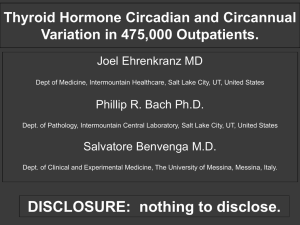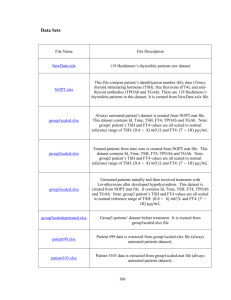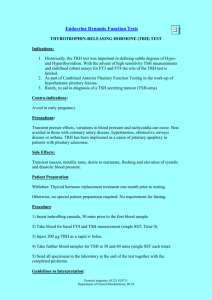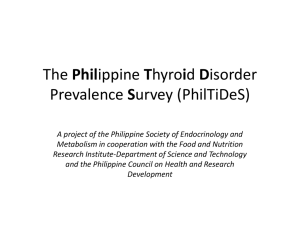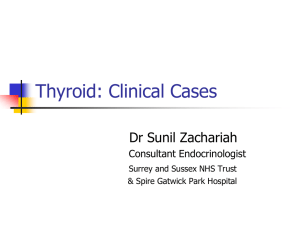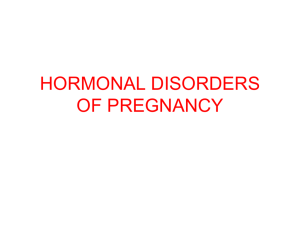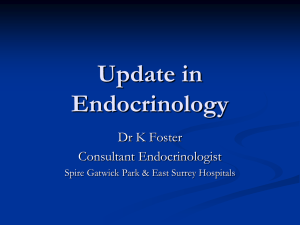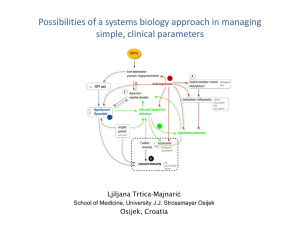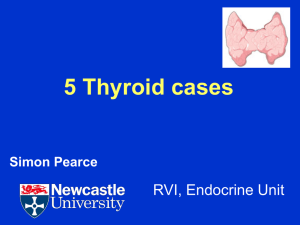thyroid-in-pregnancy-8-9-11
advertisement
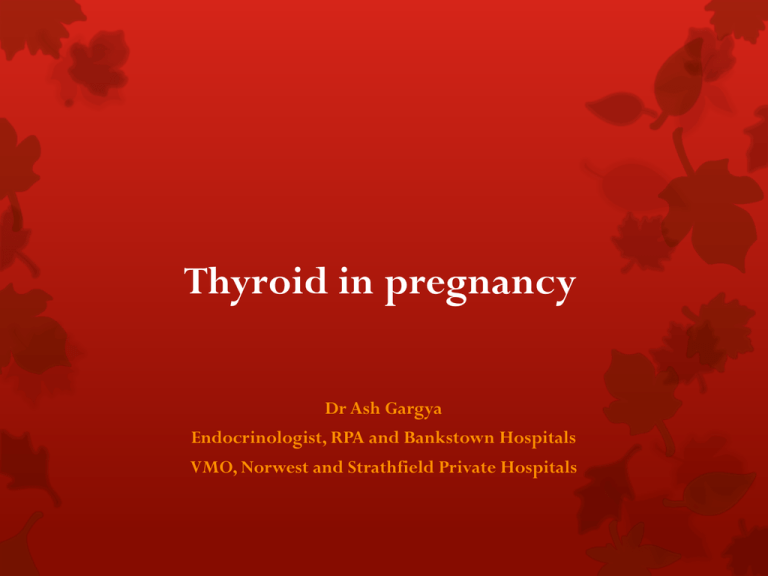
Thyroid in pregnancy Dr Ash Gargya Endocrinologist, RPA and Bankstown Hospitals VMO, Norwest and Strathfield Private Hospitals Maternal physiology and TSH recommendations Changes in maternal thyroid physiology 0 10 20 30 40 Gestation (wks) • E2 ↑ TBG synthesis (2-fold) and sialylation → ↓ TBG plasma clearance → ↑ in total T4 (and T4 binding sites) and T3 • ↑ volume of distribution and placental T4 transfer (accounts for 35% cord T4) • hCG has TSH-like activity → peak 10-12 wks → 1st trimester ↑ fT4 (i.e. thyroid hormone pool) and ↓ TSH (~20% pregnancies) • ↑GFR → ↑ (2-fold) urinary iodine loss “Strains” the thyroid functional reserve esp if ATA +ve or iodine insufficient What crosses the placenta? T4 • TSH and T3 do not cross the placenta Iodine Anti-thyroid medications • PTU and carbimazole TSH receptor antibodies • A maternal level >3 times ULN in the third trimester may increase the risk of neonatal Graves’ TSH reference ranges in pregnancy 97.5th centile Mean 2.5th centile 9 studies between 2004-2009 ATA –ve and iodine sufficient Non-pregnant TSH reference range (0.4-4.1)mIU/L Glinoer D. Nat Rev Endo 2010 Current recommendations Where available, use laboratory-specific and trimesterspecific reference ranges in pregnancy When not available, aim for:Pre-conception TSH 0.3-2.5mIU/L 1st trimester TSH 0.1-2.5mIU/L 2nd trimester TSH 0.3-3.0mIU/L 3rd trimester TSH 0.3-3.0mIU/L ATA Guidelines July 2011 Current recommendations fT4 less reliable in pregnancy • Depends on methodology (ED and MS gold standard) • Effect of iodine insufficiency When is fT4 measurement useful? • Differentiate OH from SH • Monitoring anti-thyroid therapy o Aim fT4 upper non-pregnant RR (i.e. 15-20pmol/L) • Central hypothyroidism ALL pregnant and breastfeeding women should be on an iodinecontaining (250mcg) supplement Who should be screened pre-conception? Universal screening is currently NOT advocated Maternal hypothyroidism What are the implications of maternal hypothyroidism? OVERT hypothyroidism (OH) • Definition: TSH >2.5 with low fT4 • TSH >10 regardless of fT4 • Obstetric: associated with miscarriage, SGA, prematurity, gestational hypertension and PPH • Fetal: 7 point IQ deficit (age 7-9yo) with delays in language, attention and motor development [untreated maternal TSH>13] (Haddow 1999) • T4 therapy IMPROVES outcomes (obstetric and fetal) What are the implications of maternal hypothyroidism? SUBCLINICAL hypothyroidism (SH) • Affects 2-3% of all pregnancies • Definition: TSH 2.5-10 with normal fT4 • Obstetric: associated with increase risk of miscarriage and pre-term delivery (OR 2-2.5 across multiple studies) • Fetal: no convincing evidence that SH affects neuro-cognitive development • SCARCE evidence confirming that T4 intervention improves outcomes (obstetric or fetal) Adjusting and monitoring TFT on Thyroxine For women with pre-existing hypothyroidism on Thyroxine • Aim TSH 0.3-2.5 pre-conception • Once pregnant, increase dose by 30% (usually = 2 extra tablets through the week) • For athyreotic women a dose increase up to 50% is needed • Monitor TFT 4-weekly till 20 weeks and once at 28-32 weeks • Take prenatal/Ca/Fe supplements >3h gap from Thyroxine • Post-delivery reduce to pre-pregnancy dose with 3-monthly monitring for 1 year • Hashimoto’s: dose may be 20% higher 1 year postpartum cf pre-preg What are the implications of positive thyroid autoimmunity? Occurs in 5-15% of child-bearing women Positive thyroid antibodies are associated with • SH and OH • Postpartum thyroiditis (risk 30-50% if +ve in 1st trimester) • Increased rate of miscarriage (OR 2.73) o ?Heightened immune dysregulation o ?Thyroid hypofunction o ?Increased maternal age What are the implications of positive thyroid autoimmunity? Guidelines recommend treating with T4 if • Euthyroid and history of recurrent miscarriage • SH If euthyroid with +ve ATA pre-conception • 20% of these women will have a TSH>4 by the 3rd trimester • Monitor 4-6 weekly till mid-gestation (and once at 28-32 weeks) for SH/OH • Monitor TFT 3-monthly pp - increased risk of pp thyroiditis ATA guidelines 2011 Maternal hyperthyroidism What are the implications of maternal hyperthyroidism? Affects 0.1-0.4% of pregnancies 85% have Graves’ disease • Other causes include hCG-mediated thyrotoxicosis (hyperemesis gravidarum, twin pregnancy), toxic nodule/s, thyroiditis (subacute, postpartum – M/C or delivery <12 months), molar pregnancy Overt hyperthyroidism associated with miscarriage, IUGR, preeclampsia, preterm delivery, thyroid storm, CCF Subclinical hyperthyroidism is NOT associated with adverse fetomaternal outcomes How to approach a low TSH in early pregnancy Check fT4, TRAb • If both elevated – treat with antithyroid meds • fT3 may help confirm Graves’ - T3 toxicosis (DD AFTN) • If normal fT4 and +ve TRAb – monitor TFT 4-weekly and treat once overtly hyperthyroid • If normal fT4 and –ve TRAb, likely hCG-mediated thyrotoxicosis Graves’ disease in pregnancy Use lowest effective dose of ATD PTU in the 1st trimester (monitor LFT) and carbimazole thereafter if continued therapy required Maintain fT4 in the upper 1/3 of non-pregnant RR Monitor TFT 4-weekly whilst on ATD Check TRAb around 28-32 weeks – risk neonatal Graves’ 1/3 women can stop ATD by 3rd trimester High risk of relapse 4-8 months postpartum Summary Summary Use laboratory-specific, trimester-specific RR in pregnancy TSH 0.3-2.5 pre-conception and during the 1st trimester TSH 0.3-3.0 during the 2nd and 3rd trimesters If on Thyroxine, increase dose by 30-50% once pregnant with 4weekly monitoring in the first half of pregnancy ALL women should take an iodine–containing supplement Maintain fT4 in upper 1/3 non-preg RR if on ATD


